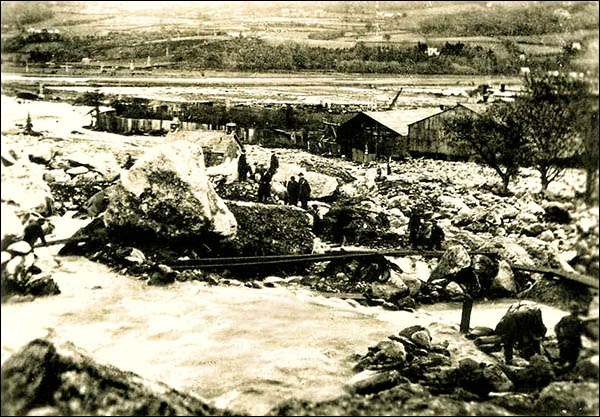Dolgarrog dam disaster memorial
![]()
![]()
 This memorial commemorates the victims of the dam disaster in Dolgarrog on the dark and stormy night of 2 November 1925.
This memorial commemorates the victims of the dam disaster in Dolgarrog on the dark and stormy night of 2 November 1925.
 Water had been seeping for years under the dam at Llyn Eigiau, up in the mountains west of Dolgarrog. After a dry summer and wet autumn in 1925, the water seepage under the dam rapidly increased and eroded a large rectangular opening in the ground under the dam wall's shallow foundation; the dam wall and foundation remained intact and spanned the opening.
Water had been seeping for years under the dam at Llyn Eigiau, up in the mountains west of Dolgarrog. After a dry summer and wet autumn in 1925, the water seepage under the dam rapidly increased and eroded a large rectangular opening in the ground under the dam wall's shallow foundation; the dam wall and foundation remained intact and spanned the opening.
The amount of water which gushed through the hole would have caused relatively little damage had it been diverted before reaching Coedty reservoir, lower down the same side valley. Instead, Coedty’s embankment dam was overtopped. The dam’s core suddenly collapsed, sending a tidal wave of millions of gallons of water cascading down the narrow gorge – carrying giant boulders weighing many tons – towards the unsuspecting villagers of Dolgarrog.
By the following day the death toll was 10 adults and six children. The nearby Aluminium Corporation factory was seriously flooded but the 200 or so workers there were all successfully rescued. The death toll might have been higher had not most of the villagers been attending a cinema show in the community hall on higher ground.
Stanley Taylor was at a Scouts meeting when the flood hit his family home. He died trying in vain to rescue his wife and infant daughter from the wreckage. Their grave is in the Great Orme cemetery.
The disaster prompted Parliament to legislate for better safety standards at reservoirs. The Reservoirs (Safety Provisions) Act of 1930 included regulations about maintenance of old dams, as well as construction of new ones. This was a belated to response to many dam failures in Britain, including one which killed 12 people in South Wales in 1875.
The hydro power station, still here today, provided electricity to the towns of Llandudno, Colwyn Bay and Conwy. It was put out of action by the sudden flooding, plunging the coastal towns into darkness. A memorial walk was created in the boulder field in 2004. Some of the boulders brought down by the torrent are estimated to weigh over 500 tons.
The photo above, courtesy of the Conwy Archives Service, shows an expanse of boulders and other debris in Dolgarrog after the disaster, with part of the aluminium factory in the middle distance.
With thanks to John Lawson-Reay and to David Greatrex, former Dŵr Cymru Reservoir Safety Manager
Postcode: LL32 8JU View Location Map
Website of the Conwy Archive Service
Footnotes: The dam disaster victims
- Elizabeth Brown, aged 46, of No.1 Bungalow.
- Betty Brown, aged 3. Daughter of Elizabeth Brown.
- Susan Evans, 3 Machno Terrace.
- Ceridwen Evans, aged 5. Daughter of Susan Evans.
- Bessie Evans, aged 3. Daughter of Susan Evans.
- Gwen Evans, aged four months. Daughter of Susan Evans.
- Harold Victor Higgins, aged 30. Lodger at 2 Machno Terrace. Came from near Welshpool.
- Catherine McKenzie, aged 36, of 2 Dolgarrog Cottages.
- Mona McKenzie, aged 5. Daughter of Mrs McKenzie.
- Margaret Sinott, aged 63, of Porth Llwyd Cottage.
- Stanley Taylor, 1 Machno Terrace.
- Dorothy Taylor, wife of Stanley.
- Sylvia Taylor, aged 17 months. Daughter of Stanley and Dorothy Taylor.
- Mary Williams, aged 66, of 2 Machno Terrace.
- William Twynham, aged 52, of Tai’r Felin.
- Jennie Twynham, aged 52. Wife of William.


